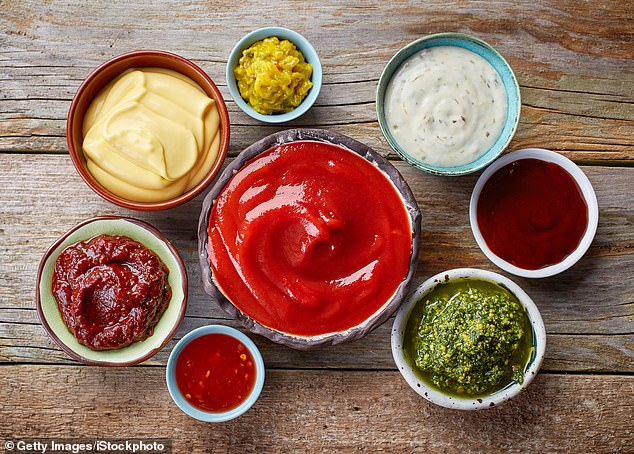How much salt and sugar are in YOUR favorite sauces? Use this guide to find out: A shock probe has found that just 1 tablespoon of the worst offenders can be eight times saltier than McDonald’s fries
Just one tablespoon of Britain’s best-loved sauces can be eight times saltier than a portion of McDonald’s chips.
MailOnline examined the nutritional value of more than 30 spices, including those from Heinz, Hellmann’s and HP.
Analysis found that one tablespoon of soy sauce can contain almost half the recommended salt limit per day for adults. Meanwhile, the same amount of sweet chili sauce contains almost a third of a person’s daily sugar intake.
Dietitians warn that consuming too much salt or sugar can contribute to high blood pressure, which can cause heart attacks and strokes.
The full results of our audit can be found in the interactive graph below.
Hover over each product to see the exact number of calories, fat, salt and sugar per 100 g/ml.
Kikkoman soy sauce topped the charts for salt, with a salt content of 16.9g per 100ml.
But in real terms this amounts to 5 grams per two tablespoons – a typical portion for stir-fries.
Similar high salt levels lurked in Amoy dark soy sauce (15.8 g per 100 ml), Colman’s English mustard (8.4 g per 100 g) and Tabasco sriracha sauce (6.7 g per 100 ml).
For comparison, a medium portion of McDonald’s fries contains 0.62 grams.
Broken down per pound, this equates to 0.54g per 100g, meaning some sauces are up to 31 times as salty.
Eating more than the NHS-recommended 6 grams of salt per day can lead to high blood pressure, increasing the risk of heart attacks and strokes.
About three-quarters of the salt in our diet comes from packaged foods.
Victoria Taylor, nutrition lead at the British Heart Foundation, told MailOnline: ‘Most of us eat too much salt.
‘You may think you don’t have to worry about salt if you don’t add it to your cooking, but most of the salt we consume is already in the food we buy, including spices.’
While people who occasionally eat condiments in the recommended portion sizes should be fine, the high salt content can add up over time, Ms. Taylor said.
Ms. Taylor recommended homemade low-salt alternatives, such as a Tzatziki-style dip, mixing low-fat yogurt, garlic, and chopped cucumber.
Soy sauce is high in salt because, along with soybeans and wheat, it is one of the main ingredients used to make the seasoning. In addition to stir-fry dishes, soy sauce is often eaten with sushi, fried rice and dumplings.
A spokesperson for Kikkoman said: ‘All soy sauces contain a high amount of salt, which is inherent to the characteristic flavor profile of the product.
‘However, there is some scientific research showing that replacing salt with soy sauce can actually help reduce overall salt intake.’
But hot sauces and mustard are also packed with salt.
Colman’s Mustard contains 8.4g of salt per 100g, or the equivalent of 0.42g in a single serving, which is 5g according to the packaging.
Tabasco Siracha Hot Chili Sauce contains 6.7 g of salt per 100 ml. However, a typical serving of one teaspoon contains 0.3 g.
There’s also a surprising amount of sugar packed into flavorful sauces.
Blue Dragon Original Thai Sweet Chili Sauce contains 54.7 g of sugars in a 100 ml serving, or 16.4 g in a two tablespoon serving.
Meanwhile, 100g of Heinz Tomato Ketchup contains 22.8g. That amounts to about 6.8 grams per two-tablespoon serving.
To put that into context, health chiefs recommend consuming no more than 30 grams of free sugars added to food and drink every day.

The high amount of fat, salt and sugar found in spices can give your food an extra kick, but can be harmful to your heart health
For comparison, an original Krispy Kreme glazed donut contains 12 grams of sugar, while a can of Coca-Cola contains 35 grams.
Too much sugar increases the risk of tooth decay and weight gain.
Creamy condiments such as mayonnaise, salad cream and tartar sauce, on the other hand, contain a large amount of fat.
100 g of Hellmann’s Real Mayonnaise contains 79 g of fat and 6.2 g of saturated fat. That’s 11 g of fat and 0.9 g of saturated fat per tablespoon.
That’s almost half the fat in a medium McDonald’s fries, which contains 17 g of fat and 1.5 g of saturated fat.
Britons are told to limit saturated fat content to 20 grams for women and 30 grams for men.
That’s because eating too much over time can raise cholesterol, which in turn increases the risk of heart attacks and strokes.
